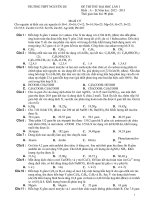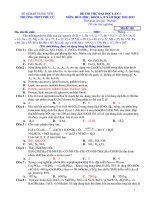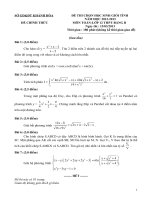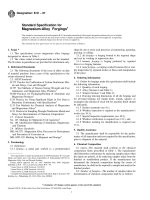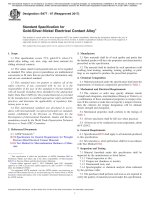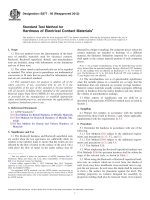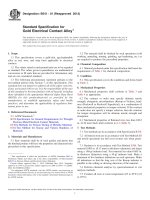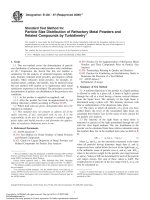Astm b 540 97 (2012)
Bạn đang xem bản rút gọn của tài liệu. Xem và tải ngay bản đầy đủ của tài liệu tại đây (75.17 KB, 3 trang )
Designation: B540 − 97 (Reapproved 2012)
Standard Specification for
Palladium Electrical Contact Alloy1
This standard is issued under the fixed designation B540; the number immediately following the designation indicates the year of
original adoption or, in the case of revision, the year of last revision. A number in parentheses indicates the year of last reapproval. A
superscript epsilon (´) indicates an editorial change since the last revision or reapproval.
This standard has been approved for use by agencies of the Department of Defense.
1. Scope
3. Materials and Manufacture
1.1 This specification covers an alloy containing palladium,
silver, copper, gold, platinum, and zinc in the form of wire, rod,
and strip for electrical contacts.
3.1 Raw materials shall be of such quality and purity that
the finished product will have the properties and characteristics
prescribed in this specification.
1.2 The values stated in inch-pound units are to be regarded
as standard. The values given in parentheses are mathematical
conversions to SI units that are provided for information only
and are not considered standard.
3.2 The material shall be finished by such operations (cold
working, heat treating, annealing, turning, grinding, pickling)
as are required to produce the prescribed properties.
4. Chemical Composition
1.3 The following safety hazard caveat pertains only to the
test methods portion, Section 6 of this specification. This
standard does not purport to address all of the safety concerns,
if any, associated with its use. It is the responsibility of the user
of this standard to become familiar with all hazards including
those identified in the appropriate Material Safety Data Sheet
(MSDS) for this product/material as provided by the
manufacturer, to establish appropriate safety and health
practices, and determine the applicability of regulatory limitations prior to use.
1.4 It is the responsibility of the user to become familiar
with all hazards including those identified in the appropriate
Material Safety Data Sheet (MSDS) for this product/material
as provided by the manufacturer.
4.1 Material produced under the specification shall meet the
requirements of chemical composition shown in Table 1.
5. Mechanical Properties
5.1 The contract or order may specify ultimate tensile
strength, elongation, mirohardness (Knoop or Vickers), or a
combination of these mechanical properties (as listed in Table
2, Table 3, and Table 4) as temper criterion. If the contract or
order does not specify a temper criterion, then the criterion for
temper designation will be ultimate tensile strength and elongation.
6. Test Methods
6.1 Test methods shall be in accordance with Specification
B476.
6.1.1 Knoop hardness tests shall be in accordance with Test
Method E384. Material 0.005 in. (0.13 mm) in thickness
(diameter) and larger shall be tested using a 100-g indenter
load. Material less than 0.005 in. (0.13 mm) in thickness
(diameter) shall be tested using a 50-g indenter load. A
minimum of five hardness indentations shall be made on each
specimen. All indentations shall be made so that the long axis
of the indenter is parallel to the rolling or drawing direction of
the material. The hardness value reported shall be the average
of the five indentations.
6.1.2 All tension test specimens shall be full cross-section
size when practical (see Test Methods E8).
6.1.3 All tests shall be conducted in room temperature, 65 to
85°F (18.3 to 29.4°C).
2. Referenced Documents
2.1 ASTM Standards:2
B476 Specification for General Requirements for Wrought
Precious Metal Electrical Contact Materials
E8 Test Methods for Tension Testing of Metallic Materials
E384 Test Method for Knoop and Vickers Hardness of
Materials
1
This specification is under the jurisdiction of ASTM Committee B02 on
Nonferrous Metals and Alloys and is the direct responsibility of Subcommittee
B02.05 on Precious Metals and Electrical Contact Materials.
Current edition approved Nov. 1, 2012. Published November 2012. Originally
approved in 1970. Last previous edition approved in 2008 as B540 – 97 (2008)ε1.
DOI: 10.1520/B0540-97R12.
2
For referenced ASTM standards, visit the ASTM website, www.astm.org, or
contact ASTM Customer Service at For Annual Book of ASTM
Standards volume information, refer to the standard’s Document Summary page on
the ASTM website.
6.2 Chemical analysis shall be performed by spectrochemical or wet analysis methods.
Copyright © ASTM International, 100 Barr Harbor Drive, PO Box C700, West Conshohocken, PA 19428-2959. United States
1
B540 − 97 (2012)
TABLE 1 Chemical Requirements
Composition,
weight %
Element
Palladium
Silver
Copper
Gold
Platinum
Zinc
Total platinum group metal impurities
(iridium, osmium, rhodium, ruthenium)
Total base metal impurities
34.0–36.0
29.0–31.0
13.5–14.5
9.5–10.5
9.5–10.5
0.8–1.2
0.1 max
0.2 max
TABLE 2 Mechanical Properties of WireA
(0.004 to 0.020 in. (0.1 to 0.5 mm) diameter)
Temper
Property
Tensile strength, ksi
Tensile strength, MPa
Elongation, % in 2 in. (51 mm)
Hardness, KnoopB
Hardness, Vickers, 100-g load (50-g
under 0.005-diameter)
A
B
SolutionAnnealed
StressRelieved
Ductile
Heat-Treated
Age-Hardened
Heat Treated
Age-Hardened
110–130
760–900
20 min
200–260
190–250
140–170
970–1170
10–20
280–340
265–340
160–190
1100–1310
8–18
320–370
320–380
160–200
1100–1380
1–10
350–410
330–400
The limits to all properties apply only to the sizes specified.
See 6.1.1.
TABLE 3 Mechanical Properties of WireA
(Over 0.020 to 0.040 in. (0.5 to 1.0 mm) diameter)
Temper
Property
Solution-Annealed
Stress-Relieved
Ductile-Hardened
Age-Hardened
105–130
720–860
15 min
200–260
190–250
130–170
900–1170
8–25
280–340
265–340
155–180
1070–1240
8–25
310–360
320–380
160–200
1100–1380
1–10
340–400
330–400
Tensile strength, ksi
Tensile strength, MPa
Elongation, % in 2 in. (51 mm)
Hardness, KnoopB
Hardness, Vickers:
100-g load
A
B
The limits to all properties apply only to the sizes specified.
See 6.1.1.
TABLE 4 Mechanical Properties of StripA
(0.003 to 0.020 in. (0.075 to 0.5 mm) thick)
Property
Temper
Solution-Annealed
Stress-Relieved
Ductile-Hardened
Age-Hardened
110–135
760–930
12 min
200–260
185–255
135–160
930–1100
8–25
280–340
265–340
150–185
1030–1280
8–25
300–360
320–380
160–200
1100–1380
1–10
340–400
330–400
Tensile strength, ksi
Tensile strength, MPa
Elongation, % in 2 in. (51 mm)
Hardness, KnoopB
Hardness, Vickers 100-g load (50-g load under
0.005 thick)
A
B
The limits to all properties apply only to the sizes specified.
See 6.1.1.
7. Inspection and Testing
7.1.2 Tension or hardness tests, or both, for temper
verification,
7.1.3 Dimensional inspection, and
7.1 Material furnished under this specification shall be
inspected and tested by the manufacturer as listed below:
7.1.1 Visual inspection at 10× magnification,
2
B540 − 97 (2012)
7.1.4 Chemical analysis when indicated by the purchase
order.
8. Keywords
8.1 contact; electrical contact material; palladium alloy;
precious metal
APPENDIX
(Nonmandatory Information)
X1. REFERENCE PROPERTIES OF PALLADIUM ALLOY ELECTRICAL CONTACT MATERIAL
TABLE X1.1 Typical Physical Properties
Resistivity, µΩ· cm
Density, Mg/m3
Solidus temperature, °C
Linear coefficient of thermal expansion/°C (23-100°C)
Thermal emf versus platinum (0-100°C), µ V/°C
Softening voltage, mV
Melting voltage, mV
Fatigue strength (rotating-bending)
at 108 cycles:
ksi
MPa
Modulus of elasticity in tension:
ksi
MPa
Proportional limit:
ksi
MPa
SolutionAnnealed
StressRelieved
DuctileHardened
AgeHardened
34.9
11.8
1015
13.5 × 10−6
−10
220
385
33.2
11.8
1015
13.5 × 10−6
−9
220
...
31.6
11.8
1015
13.5 × 10−6
−8
220
400
31.6
11.8
1015
13.5 × 10−6
−8
220
400
50
345
50
345
50
345
50
345
17 × 103
117 × 103
17 × 103
117 × 103
17 × 103
117 × 103
17 × 103
117 × 103
90
620
135
930
135
930
145
1000
X1.1 Table X1.1 provides a list of typical property values
which are useful for engineering calculations in electrical
contact design and application.
ASTM International takes no position respecting the validity of any patent rights asserted in connection with any item mentioned
in this standard. Users of this standard are expressly advised that determination of the validity of any such patent rights, and the risk
of infringement of such rights, are entirely their own responsibility.
This standard is subject to revision at any time by the responsible technical committee and must be reviewed every five years and
if not revised, either reapproved or withdrawn. Your comments are invited either for revision of this standard or for additional standards
and should be addressed to ASTM International Headquarters. Your comments will receive careful consideration at a meeting of the
responsible technical committee, which you may attend. If you feel that your comments have not received a fair hearing you should
make your views known to the ASTM Committee on Standards, at the address shown below.
This standard is copyrighted by ASTM International, 100 Barr Harbor Drive, PO Box C700, West Conshohocken, PA 19428-2959,
United States. Individual reprints (single or multiple copies) of this standard may be obtained by contacting ASTM at the above
address or at 610-832-9585 (phone), 610-832-9555 (fax), or (e-mail); or through the ASTM website
(www.astm.org). Permission rights to photocopy the standard may also be secured from the ASTM website (www.astm.org/
COPYRIGHT/).
3

